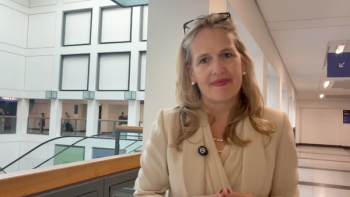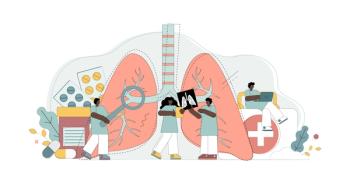
Sleep, Circadian Rhythms Affect Depressive Symptoms in Bipolar Disorder
The relationships among bipolar disorder, sleep, and circadian rhythms were emphasized in a panel held at SLEEP 2024.
In a symposium at
The Relationship Between Sleep and Bipolar Disorder
BPD, according to Michael McCarthy, MD, PhD, professor of psychiatry at UC San Diego, is a serious mental illness that affects 1% to 2% of the population, and often manifests as mania, where individuals will have higher reward-seeking and goal-directed behavior but also less sleep. BPD can be genetically inherited. Lithium is used to treat BPD, with about one-third of patients responding well and another third having a partial response to it in conjunction with other medications.
When it comes to BPD’s association with sleep, individuals diagnosed with BPD have vastly different activity sleep diagram.
“[Patients with BPD have] overall lower activity during the course of the day,” said McCarthy. “You see delayed-onset asleep and delayed waking in the mornings, and you see fragmentation of sleep.”
McCarthy also noted that individuals with BPD have decreased relative amplitude when looking at the circadian rhythms. This can affect social rhythms and social activity, which in turn can affect reward pathways for these individuals and lead to either reward seeking or depression. These are thought to all interact with the circadian clock, said McCarthy.
Circadian rhythms also have been found to affect depressive and manic symptoms. McCarthy said, “We found evening chronotype, or people who are predominantly evening-type people, showed greater depressive symptoms, more manic symptoms, [and] had a history of more suicide attempts. All of these collectively created a worse response to lithium.”
A lack of response to lithium was also associated with circadian disruption. The relationship between sleep and BPD is well established regarding lithium efficacy and mood episodes. However, sleep also has connections to other aspects of BPD, including depression levels in patients with BPD who have poor sleep.
Sleep and Its Impact on Suicidal Thoughts in BPD
Jennifer Goldschmied, PhD, assistant professor of psychiatry at the University of Pennsylvania, spoke about effects of the relationship between seasonality and sleep on BPD, primarily when it came to the disruption in circadian rhythms. Specifically, she focused on BPD types 1 and 2.
“Bipolar type 1 is characterized by episodes of mania…this is periods of 7 or more days of expansive, elevated, or irritable mood contrasted with periods of depression,” said Goldschmied. “In bipolar 2, however, we have episodes of hypomania, and this is periods of at least 4 days but not more than 7 days of elevated and expansive mood also in contrast with periods of depression.”
Goldschmied presented the results of studies that she and her colleagues have conducted that focus on BPD types 1 and 2, the first on how seasonality affects BPD and in the second on what parts of sleep affected BPD 1 and 2 the most.
Both studies used the data provided in the Prechter Bipolar Research Program, which was established in 2005 and features participants who record their manic and depressive symptoms for as long as they participate, with the median length of participation being 8 years. The first study used other questionnaires to establish mood and depression, including the Seasonal Pattern Assessment Questionnaire, the Patient Health Questionnaire (PHQ-9), and the Altman Self-Rating Mania (ASRM) scale.
Participants in the first study included 583 individuals diagnosed with BPD type 1, 164 individuals with BPD type 2, and 283 control patients. The study found that individuals with BPD had a higher self-reported seasonality compared with the healthy controls. The seasonality did not differ significantly between types 1 and 2 of BPD. The PHQ-9 and ASRM both found that manic symptoms were lower and depressive symptoms were higher in the fall and winter months. Greater mood variability was also reported in individuals with high self-reported seasonality.
As for how this connects to sleep? “One potential is that the reduction in daylight is associated with the dysregulation of the circadian rhythm,” said Goldschmied. “Dysregulation of the circadian rhythm can be associated with an increase in melatonin [and] a lot of our neurotransmitters are mediated via the circadian rhythm. So that kind of dysregulation can be dysregulating the mood neurotransmitters.”
The second study that Goldschmied presented focused on establishing which sleep and circadian parameters had an association with suicide risk in individuals with BPD and if this association changed depending on the type of BPD, as death by suicide is 10 to 30 times higher in individuals with BPD compared with the general population.1 Risk of suicide attempt has also been found to be linked to trouble falling asleep and early morning awakening, regardless of depressive symptoms.2
The Columbia Suicide Severity Rating Scale, the Hamilton Depression Rating Scale, the Pittsburgh Sleep Quality Index, and the Munich Chronotype Questionnaire were all used in this study and a stepwise selection procedure was used.
Increased suicide risk was found in individuals with “decreased enthusiasm to get things done, an evening prototype, an increase in initial insomnia, or having trouble falling asleep,” according to Goldschmied. “Increased light exposure on free days and diagnostic status of ‘healthy control’ decreased suicide risk.”
There were some small differences in BPD types 1 and 2 when evaluating the risk of suicide and which factors contributed to that. The study found that in patients with BPD type 1, trouble with enthusiasm to get things done and early morning awakenings were associated with an increased risk of suicide whereas light exposure during free days was associated with a decreased risk of suicide. For BPD type 2, only chronotype was associated with higher suicide risk.
“What we found was that self-reported sleep difficulties were a significant predictor of suicide risk even in the entire sample,” said Goldschmied. “But a unique pattern of sleep symptoms is predictive of suicide risk in each subtype of bipolar disorder.”
Goldschmied emphasized that sleep and circadian rhythms should be heavily considered when identifying and reducing the risk of suicide in patients with BPD. Targeted interventions could help to improve sleep and regulate circadian rhythms to mitigate the risk of suicide.
How Chronotype Affects BPD
Helen Burgess, PhD, codirector of the Sleep and Circadian Research Laboratory at the University of Michigan, discussed how chronotype could affect BPD types 1 and 2.
“We know that many people with [BPD types 1 and 2] are evening types,” said Burgess. “In the largest cross-sectional study to date…about 49% self-reported evening type, 35% morning type, and 16% neither type.”
Other studies have found that individuals with late chronotype were more likely to have a mood episode and a greater number of mood episodes within 1 to 1.5 years of follow up. Burgess had conducted her own study3 about the association of chronotype in BPD types 1 and 2 in 2021 while using the data from the Prechter Bipolar Research Program. The participants consisted primarily of females (70%) and the cohort had a mean (SD) age of 43.7 (13.3) years. Early, normal, and late chronotypes, respectively, made up 42%, 11%, and 46% of the overall population. There were 318 individuals with BPD types 1 and 2 included in the study.
“Overall, we found that folks with bipolar 1 and 2 who self-identify as a late chronotype have a high frequency of depressive symptoms over a 5-year follow-up,” said Burgess. “We also potentially saw a protective effect for hypomania and mania episodes.”
Burgess claimed that this result highlighted the potential usefulness of a single self-reported question in determining the course of action that a clinician should take for patients who are at a higher likelihood of depression. This also suggests, said Burgess, that light therapy could be used. However, as of right now, light therapy poses risks of inducing mania in patients with BPD, which leaves it as a treatment to be considered more in the future rather than the present.
BPD and sleep have a distinct connection between them that can affect treatment plans, suicidal thoughts, and depression depending on their type of BPD, as well as their self-reported chronotype. Clinicians should be aware of these associations when making future treatment plans and when treating a patient’s depressive symptoms.
References
1. Valtonen H, Suominen K, Mantere O, Leppämäki S, Arvilommi P, Isometsä ET. Suicidal ideation and attempts in bipolar I and II disorders. J Clin Psychiatry. 2005;66(11):1456-1462. doi:10.4088/jcp.v66n1116
2. Geoffroy PA, Oquendo MA, Courtet P, et al. Sleep complaints are associated with increased suicide risk independently of psychiatric disorders: results from a national 3-year prospective study. Mol Psychiatry. 2021;26(6):2126-2136. doi:10.1038/s41380-020-0735-3
3. Vidafar P, Yocum AK, Han P, McInnis MG, Burgess HJ. Late chronotype predicts more depressive symptoms in bipolar disorder over a 5 year follow-up period. Int J Bipolar Disord. 2021;9:28. doi:10.1186/s40345-021-00233-5
Newsletter
Stay ahead of policy, cost, and value—subscribe to AJMC for expert insights at the intersection of clinical care and health economics.

















































